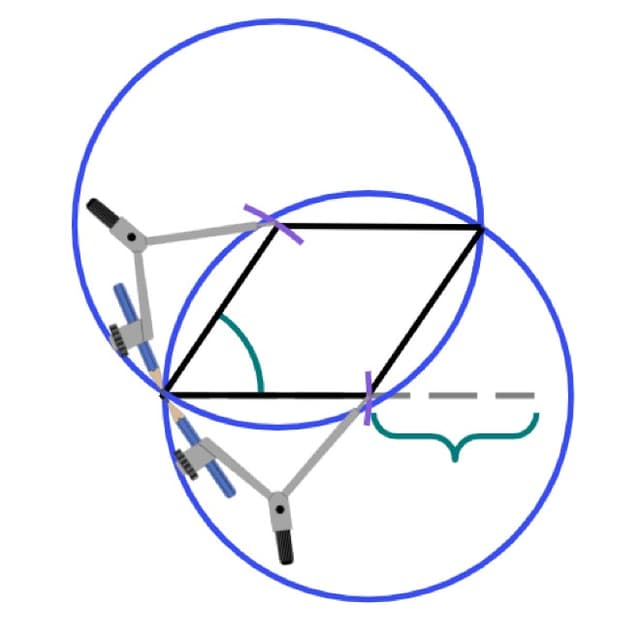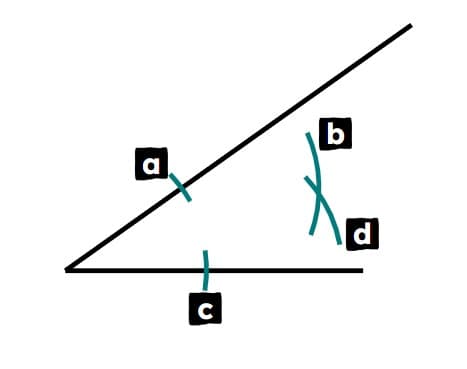Myths about teaching can hold you back


- Year 11•
- Higher


- Year 11•
- Higher
Constructing angles of 90° and 45°
I can construct angles of 90° and 45°.
These resources were made for remote use during the pandemic, not classroom teaching.
Switch to our new teaching resources now - designed by teachers and leading subject experts, and tested in classrooms.
Lesson details
Key learning points
- When constructing the perpendicular, you are constructing a 90° angle
- Bisecting a 90° angle results in two angles, each measuring 45°
Keywords
Bisect - To bisect means to cut or divide an object into two equal parts.
Complementary angles - Complementary angles are a pair of angles that sum to 90°.
Supplementary angles - Supplementary angles are a pair of angles that sum to 180°.
Conjugate angles - Conjugate angles are a pair of angles that sum to 360°.
Common misconception
Pupils may use a protractor rather than a pair of compasses.
Remind pupils that a construction is done using a pair of compasses and ruler.
To help you plan your year 11 maths lesson on: Constructing angles of 90° and 45°, download all teaching resources for free and adapt to suit your pupils' needs...
To help you plan your year 11 maths lesson on: Constructing angles of 90° and 45°, download all teaching resources for free and adapt to suit your pupils' needs.
The starter quiz will activate and check your pupils' prior knowledge, with versions available both with and without answers in PDF format.
We use learning cycles to break down learning into key concepts or ideas linked to the learning outcome. Each learning cycle features explanations with checks for understanding and practice tasks with feedback. All of this is found in our slide decks, ready for you to download and edit. The practice tasks are also available as printable worksheets and some lessons have additional materials with extra material you might need for teaching the lesson.
The assessment exit quiz will test your pupils' understanding of the key learning points.
Our video is a tool for planning, showing how other teachers might teach the lesson, offering helpful tips, modelled explanations and inspiration for your own delivery in the classroom. Plus, you can set it as homework or revision for pupils and keep their learning on track by sharing an online pupil version of this lesson.
Explore more key stage 4 maths lessons from the Loci and construction unit, dive into the full secondary maths curriculum, or learn more about lesson planning.

Equipment
Pair of compasses, protractor, ruler.
Licence
Prior knowledge starter quiz
6 Questions
Q1.Andeep constructs the bisector of an angle of 104°. Andeep has made angles of °.
Q2.The diagram shows two congruent isosceles triangles put together to form a rhombus. Match each angle to its size.

$$a$$° -
32°
$$b$$° -
64°
$$c$$° -
116°
Not a marked angle -
44°
Q3.Here are the steps to construct a rhombus given the legs of an angle. Match each step to the correct instruction.

Step 1 -
Set your compasses to a width equal to the shorter of the two legs.
Step 2 -
Place your compass needle on the vertex of the angle.
Step 3 -
Make an arc on each leg, then place the compass needle on one arc.
Step 4 -
Place the pencil on the vertex of the angle. Draw a circle.
Step 5 -
Repeat on the open endpoint of the other leg.
Step 6 -
Draw lines with a ruler to connect the points to form a rhombus.
Q4.Jacob wants to construct a rhombus using an angle with leg lengths of 10 cm and 15 cm. The maximum radius of each circle in the construction of this rhombus is cm.

Q5.Lucas begins construction of a rhombus from this angle. Which point is the final vertex of the rhombus?

Q6.Jun is constructing an angle bisector. Here are the construction marks. Which two arcs did Jun draw first?

Assessment exit quiz
6 Questions
Q1.Complementary angles are a pair of angles that sum to °.
Q2.The diagram shows the perpendicular to UV that passes through the point T. The perpendicular intersects UV at point S. Which of these constructions will produce a 45° angle?

Q3.EC is a perpendicular to BD. The angle BOE is bisected. Match each angle to its size.

Angle BOC -
90°
Angle AOE -
45°
Angle AOD -
135°
Reflex angle AOE -
315°
Reflex angle AOD -
225°
Q4.The line segments AB and BC form an angle of 110°. Which of these constructions creates a 55° angle?

Q5.Line segments AB and BC are the legs of a 124° angle. The diagram shows the two constructions that are applied to ABC. The angle $$x$$° is °.

Q6.Line segments AB and BC are the legs of a 124° angle. The diagram shows the two constructions that are applied to ABC. The angle $$z$$° is °.


